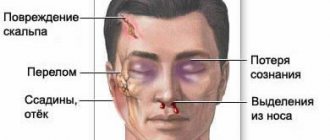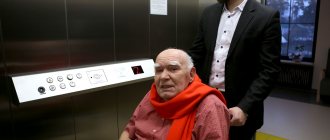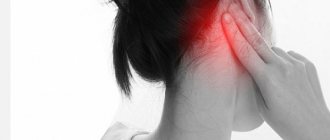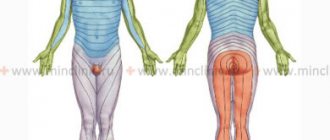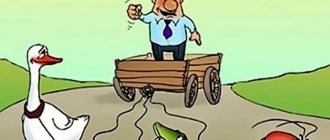Post-traumatic headache occurs after a head or neck injury. In fact, headache is the most common symptom that people experience after even mild traumatic brain injury.
The pain may begin immediately or a week after the injury. For many patients, especially those who have had a severe injury, headaches can be a problem for months, years, or a lifetime. If headaches develop within 2 weeks of injury and persist for more than several months, it is considered to be the chronic phase of post-traumatic headache. Sometimes patients do not develop headaches until several months after the injury, but in general, headaches usually begin within hours or days after the injury.
It is very difficult to predict the possibility of developing chronic post-traumatic headache in patients who have suffered trauma. In general, patients with pre-existing headaches or migraines are at higher risk. Patients with a family history of migraine may be at increased risk of developing chronic headaches. The severity of the injury can also help with prognosis, but many patients endure months or years of severe headaches after a trivial head injury. Rear-end collisions without head trauma usually result in severe headaches and neck pain. Factors such as the angle of impact, where the patient was sitting in the car, and where the force was placed on the head are key elements in the development of headaches.
Headaches are usually of two types:
- by type of tension headaches, which can be daily or episodic
- migraine headaches, which are usually more severe.
In some patients, post-traumatic migraine pain can be a serious problem, with intermittent severe headaches lasting hours to days. In other patients, tension-type headache is the predominant problem. In many patients with PTTH, pain can be mixed.
Occipital pain is often associated with neck pain and is usually of muscular origin.
Types of Injuries that Cause Post-Traumatic Headaches
- Violence
- Car crashes
- A fall
- Sports injuries
Symptoms
- Headache
- Pain in the neck
- Headaches worsen with exertion, coughing, bending or moving the head
- Dizziness
- Double vision
- Memory disorders
- Loss of appetite
- Hearing impairment
- Nausea and vomiting
- Changes in sense of smell or taste
- Problems concentrating
- Tinnitus
- Noise sensitivity
- Sensitivity to light
- Anxiety
- Depression
- Sleep problems
- Muscle spasms in the head, neck, back and shoulders
- Fatigue
Drawing conclusions
Strokes are the cause of almost 70% of all deaths in the world. Seven out of ten people die due to blocked arteries in the brain. And the very first and main sign of vascular blockage is a headache!
Particularly scary is the fact that most people do not even suspect that they have a disorder in the vascular system of the brain. People take painkillers - a pill for the head, thereby missing the opportunity to fix something, simply dooming themselves to death.
Blockage of blood vessels results in a disease under the well-known name “hypertension”, here are just some of its symptoms:
- Headache
- Increased heart rate
- Black dots before the eyes (floaters)
- Apathy, irritability, drowsiness
- Blurred vision
- Sweating
- Chronic fatigue
- Swelling of the face
- Numbness and chills in fingers
- Pressure surges
Diagnostics
The International Headache Society defines criteria for post-traumatic headache such as:
- Headache that does not have typical characteristics and meets criteria C and D
- Having a head injury with all of the following symptoms:
- Without and with loss of consciousness, which lasted no more than 30 minutes
- Glasgow Coma Scale score (which is used to assess level of consciousness after traumatic brain injury) is equal to or greater than 13
- Symptoms that are diagnosed as a concussion
- Headache develops within seven days after traumatic brain injury
- One or other of the following:
- Headache resolves within three months after head injury
- The headache has not disappeared, but the injury was less than three months ago
To diagnose this type of headache, as a rule, such types of studies as MRI, CT, PET, EEG are used, since it is necessary to clearly visualize morphological changes in brain tissue and exclude life-threatening conditions.
What is post-traumatic headache?
Headache can be one of the manifestations of injury to the head, neck or brain. Often, a headache associated with an injury is accompanied by a number of other symptoms: dizziness, increased fatigue, difficulty concentrating, nervousness, sleep disturbance, etc. This complex of manifestations is called post-traumatic (post-concussion) syndrome; As a rule, headache is the most constant and significant manifestation.
The identification of post-traumatic headache is not based on the characteristics of pain experienced by a person or the characteristics of the main links in its development, but reflects only the connection in the time of the appearance of a new or worsening of a previously existing headache with a head, neck or brain injury.
How can post-traumatic headache manifest itself? After a head injury, a number of pain manifestations may occur, some of which occur as primary headaches, most often (in 80% of people) as tension headaches (see other articles on the site). Manifestations that resemble other primary headaches have been described (see other articles on the site), therefore in the literature it is customary to describe post-traumatic headaches by analogy with primary ones:
- Post-traumatic tension headaches;
- Post-traumatic migraine;
- Post-traumatic cluster headache.
Who is more likely to suffer from post-traumatic headaches? Women are more predisposed to developing post-traumatic headaches, and in older people, recovery is slower and residual effects may be more common.
The mechanism of injury, such as tilting or turning the head during it, increases the risk of developing post-traumatic headaches.
Does the severity of injury influence the nature of post-traumatic headache? It has been observed that the severity of head injury is inversely related to the development of post-traumatic headache. Thus, head injuries that lead to skull fractures are accompanied by fewer complaints than minor injuries, that is, with more severe injuries, post-traumatic headaches are less common. On the other hand, minor injuries may not be taken into account by the person himself as a possible cause of the development of post-traumatic headache.
Treatment
Medicines are the cornerstone of treatment. During the first three weeks of headache, abortifacient medications are usually used. If headaches continue after three weeks, then additional therapy is prescribed.
Abortion therapy
The choice of abortive therapy depends on the type of headache. The main medications for the treatment of post-traumatic tension-type headaches are analgesics and NSAIDs. Muscle relaxants are more effective for PTTH than for regular tension headaches due to the presence of cervical muscle spasm. But these drugs are recommended to be taken only for 1-2 weeks. If the pain persists, then preventive treatment is necessary. If post-traumatic headaches are migraine in nature, then the same drugs are used as for migraines. Antiemetic drugs are effective for many patients. Primary abortive migraines include: Excedrin, aspirin, naproxen (Naprosyn or Anaprox), ibuprofen (Motrin), ketorolac (Toradol), Midrin, Norgesic Forte, Butalbital, Ergotamines, Sumatriptan, corticosteroids, narcotics, and sedatives.
Preventative treatment
During the first 2-3 weeks after injury, abortive drugs such as anti-inflammatory drugs are usually used. Most patients do not need to take daily preventive medications, and post-traumatic headaches gradually improve over time.
The most commonly used preventative treatments are antidepressants, especially amitriptyline (Elavil) or nortriptyline (Pamelor) and beta blockers. NSAID drugs often have a dual purpose, functioning as an abortifacient and preventive treatment. Antidepressants that have a sedative effect, especially amitriptyline, often reduce daily headaches while improving sleep. In severe cases, it is necessary to use both beta blockers and antidepressants. Non-drug treatment methods may include various physical procedures and acupuncture.
Pain after injury (accident, fall)
"OSTEOMED" successfully treats post-traumatic conditions after spinal injuries and traumatic brain injuries.
Cervicocranial syndrome is a painful condition of the cervico-occipital junction resulting from trauma to the head or neck (cervical spine) with irritation of pain receptors in the ligaments, intervertebral joint capsules, muscles of the cervical spine and aponeurosis in the occipital part of the skull.
The source of pain in the neck and back of the head is injury to the supporting structures of this area (trauma or bruise of the cervical spine). In terms of the time of occurrence, injury to the cervical spine can be either acute (as a result of car accidents, falls, blows to the head or blows to the head, bruising of the neck and back of the head during a fall), or chronic (sedentary work, feeding or long-term carrying of a child in one’s arms, etc.) .d.). Acute injury to the neck (cervical spine) and cervico-occipital junction occurs when falling, colliding with another moving or stationary object, person (when skiing, snowboarding, etc.). From a similar mechanism of injury or contusion of the cervical spine, a sharp movement occurs in the cervical-occipital junction and intervertebral joints. As a result of this injury to the cervical spine, a sprain occurs in the ligaments and muscles of the neck (back, front, side group and their combinations).
Sometimes this movement in the neck can be greater than the physiological norm for the cervical spine. Then ruptures of ligaments and muscles with subluxations of the intervertebral joints and the odontoid process of the cervical vertebra are likely. Whiplash mechanism of injury to the ligaments and muscles of the neck and brain during a car accident or collision when skating, rollerblading, skiing or snowboarding, bruising of the neck and back of the head when falling. (to the picture) Depending on the intensity of pain in the back of the head and neck during injury or With a contusion of the cervical spine, the patient cannot find a comfortable sleeping position.
Chronic injury to the neck (cervical spine) and cervico-occipital junction is formed by static load from monotonous efforts over a long period of time (sedentary work). At the same time, for some time a person experiences discomfort in the neck and back of the head. Exacerbation of pain in the cervical spine can cause hypothermia, sudden movement of the head (turning the head to the side or back), and uncomfortable position of the neck during sleep.
Against the background of injury and pain in the cervical spine, irritation of the vertebral arteries occurs, which pass in the transverse sections of the cervical vertebrae.
It should be noted that in addition to neck and head pain (occiput, temples, crown), patients may also experience vestibular disorders as a result of irritation of the vertebral arteries, which are expressed by dizziness and unsteadiness when walking, nausea and vomiting, which sometimes leads to an erroneous diagnosis of a concussion brain Complaints of noise (ringing in the ears and head), numbness of the face, tongue, back of the head, and in the ear area are also possible. The headache becomes constant and debilitating.
Fatigue occurs quickly. In the morning after sleep there is no feeling that you managed to get enough sleep. Sometimes insomnia may occur against this background. General performance and attention decrease, and irritability occurs.
Diagnostics
To diagnose a neck injury (cervical spine) and cervicocranial syndrome, you should consult a doctor for a neurological examination, during which the biomechanics of the cervical spine should be assessed (range of motion, muscle tone and strength, the presence of myofascial triggers in the neck muscles, etc. .).
Based on the results of the examination, a clinical diagnosis can be made and treatment can be suggested. In the case of an unclear diagnosis, additional diagnostic instructions may be given:
- REG, USDG of vessels of the neck and brain
- X-ray of the cervical spine with functional tests
- CT scan of the cervical spine
- MRI of the cervical spine
Treatment
In case of injury to the cervical spine, therapeutic blockades can be performed in the neck muscles and intervertebral joints when conventional treatment does not have a positive effect. For this, low doses of an anesthetic (lidocaine, novocaine) and cortisone injected into the lumen of the affected joint are sufficient.
When combined with the right physical therapy regimen, these injections can provide good, long-term relief for headaches and neck pain following a cervical spine injury.
Depending on the severity of the patient’s pain in the neck, back of the head and dizziness after injury to the head or neck (cervical spine) with cervicocranial syndrome, the following therapeutic actions are possible:
- wearing a neck brace or corset (Schanz splint, Philadelphia collar)
- drug therapy (NSAIDs, analgesics, hormones)
- manual therapy
- kinesio taping
- physiotherapy
- acupuncture
- OSTEOPATHIC TREATMENT
Wearing a special neck brace or neck brace limits the range of movement in sprained ligaments and injured joints of the neck in case of cervicocranial syndrome (injury of the cervical spine). At the same time, the neck corset and neck brace create additional relief for tense and protectively spasmodic muscles as a result of a neck injury.
Against the background of restriction of movements when wearing a neck corset or neck brace, the pain symptom in the neck and back of the head with cervicocranial syndrome is eliminated much faster, which leads to a rapid restoration of the previous range of movements in sprained ligaments and injured joints of the cervical spine after a trauma to the cervical spine.
Only in our clinic, post-traumatic conditions are successfully treated by Oleg Ivanovich Muravyov, a neurologist, chiropractor, reflexologist, specialist in kinesiotaping and the manufacture of individual orthopedic insoles. Oleg Ivanovich is a specialist with extensive experience (more than 27 years), from whom you can undergo a full cycle of treatment. An individual approach and a competent combination of treatment methods allow us to achieve positive and lasting results.
